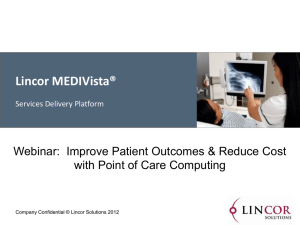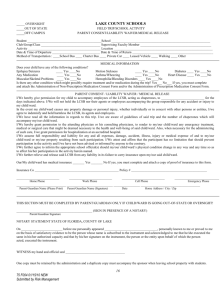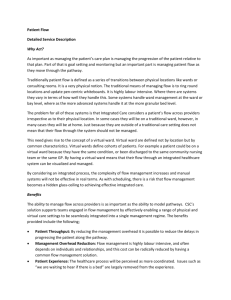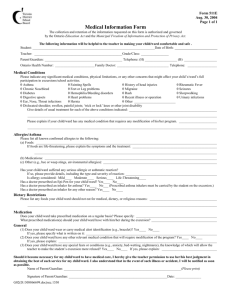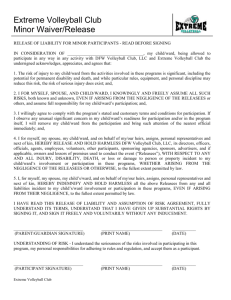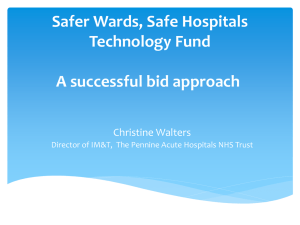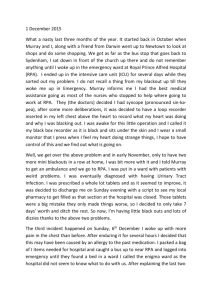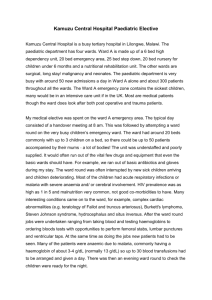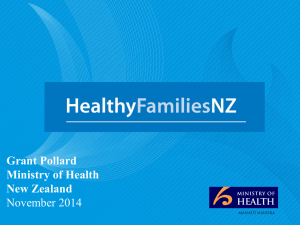Services
advertisement
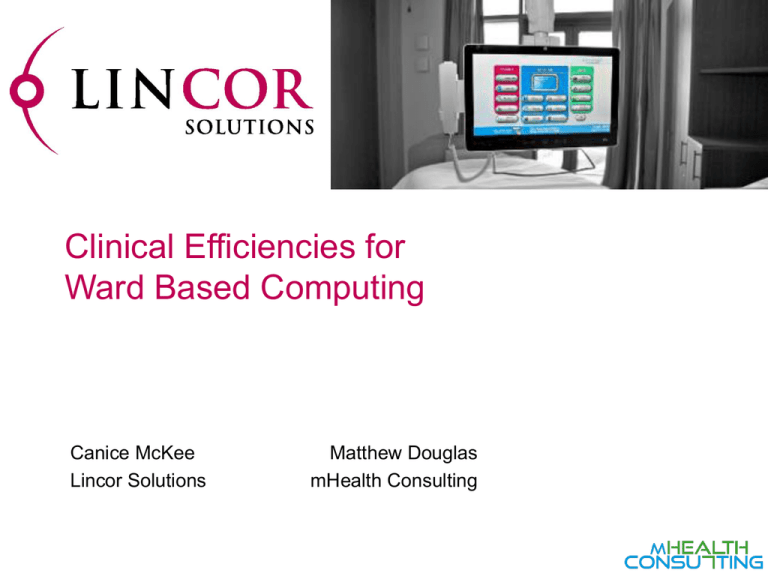
Clinical Efficiencies for Ward Based Computing Canice McKee Lincor Solutions Matthew Douglas mHealth Consulting Hospital Perfect Storm Focus on Patient Experience Reduced Income Medical Inflation Aging Population NHS Structural Changes Need to Reduce Length of Stay Increased Accountability Patient Empowerment Performance Targets Better Data Improved Outcomes Enabling Technologies Clinical, Management and Financial Information What the NIMM doesn’t tell you Enabling Technologies National Infrastructure Maturity Model Clinical Information Level 6 Description Integrated Acute/Primary Healthcare (L5 + mHealth / Telehealth) 5 Speciality support (L3 + special clinical modules) 4 Clinical Knowledge and decision support (L3 + knowledge bases, embedded guidelines, rules, alerting, decision support, multi-disciplinary care pathways) 3 Clinical Activity Support (L2 + electronic document management, order comms, group scheduling, results reporting, e-prescribing) 2 Integrated clinical diagnosis and treatment support (L1 + Master patient index) 1 Clinical Administrative Data Patient administration and departmental systems Review of technology on wards ✔ = complete - = none or almost none Full PAS functionality Results reporting PACS Order entry Nursing notes Changeover and rostering CRS/EPR Wireless Portable devices Staff and patient identification systems ePrescribing including medication admin. Procedural investigation results following examination Vital signs entry Vital signs monitoring Access to emergency services, GPs Links to social services, social care and carehomes Access to information sources and libraries (both patient and care provider) Care pathways, care planning Outcome comparison versus plan Risk assessment and a dialogue with the patient Consultant on call access The intelligent bed (pressure sores et al) Digital vital signs reporting Medical devices mostly wireless The electronic dashboard for each patient or ward providing real time clinical decision support 2007 2012 2017 ✔ Some ✔ Some Some Some Some Some Few Minimal - ✔ ✔ ✔ ✔ ✔ ✔ ✔ ✔ Widespread ✔ ✔ Some ✔ Some ✔ Some ✔ ✔ ✔ ✔ ✔ ✔ ✔ ✔ Everybody ✔ ✔ ✔ ✔ ✔ ✔ ✔ Very limited Most ✔ - Most Some Most Some Some ✔ Most ✔ ✔ ✔ Most Most - - Some London Acute Hospitals, Future Market Trends in Ward Based Computing (2007). Clinical Imperatives for Ward Based Computing • • • • • • • • • • • Support for the way that clinicians work Clinician involvement in the planning process The ability to handle structured and unstructured data Access to comprehensive complete medical information Rapid response, not more than 1 second No queues, an adequate supply of hardware Single sign-on Voice and video Robust devices Cleanable, no spreading of infections Wireless and portability London Acute Hospitals, Future Market Trends in Ward Based Computing (2007). Clinical Computing Enabling Technologies Clinical Information Single Desktop /Laptop Sign On Virtual Desktop Bedside Computing Pervasive session that follows the clinician as they go about their work Bed management Cleaning tasks Meal Ordering BYOD • • • • • • • • • • EPR OCS/e-Prescribing Group Scheduling PAS Pathology Pharmacy Radiology PACS EDM Vital Signs Monitoring Patient Services Entertainment & Communications Services • • • • • • • • Telephony & Video Calls - Integrated to Trust exchange - Skype functionality for friends and family Television Radio Internet Games Music Talking Books • • • • • Telephony & Video Calls - Virtual ward rounds for doctors - Patient Monitoring Patient Information/Education Satisfaction Surveys Meal Menus/Ordering Pain Management Environment control Full flexibility for revenue generation as decided by the Trust. The Bedside Terminal • • • Fixed Device - Always there when you need it - Minimised infection risk Usable by: - Patients - Doctors - Nurses - Admin Staff Integrated with hospital systems - Access to all patient data - Access to lab results - Access to administrative apps › Bed Management etc • High Speed, Secure Network Ward Computing – The Potential to Deliver Patient Portal Information Medication Access Bed Status Management Surveys Patient Information Education Dietary Management Translation Services Ward Efficiency Connectivity Patient Well-being Patient Discharge Entertainment Clinical Integration HIS Access Nurse Call Room Integration Patient Monitoring Room Environment Vital Signs Monitoring Medication Management Nursing Dashboard Clinical Access Business Case • • • • • • • • Working efficiencies - 15 mins/WTE = £1,042,355 pa. Reduced travel = £31,159 pa. (2% of staff) Improved clinical data quality = £42,000 pa. In Summary • 600 bed site • 3000 staff 60% clinical 40% clerical Bed management = £51,328 pa. Entertainment revenue = £195,458pa. (£1.19pcd) Advertising revenue = £205,313pa. (£1.25pcd) Includes: • Purchase of bedside computing solution • Single signon • Password self-service • Smartcard deployment • Virtual desktop (Citrix) 75% peak load • Professional services Capital investment of £2,538,079 + VAT ROI in 2 years and surplus of £3,817,886 in year 5. Thank You To Learn More: Visit us at Stand 66 www.lincor.com Twitter.com/Lincor Youtube.com/LincorSolutionsTV

